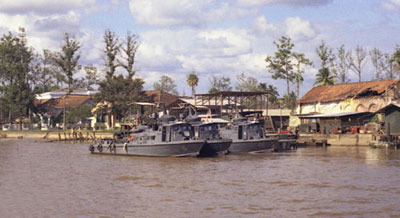
| VIETNAMIZATION |
| Accelerated Turnover to the Vietnamese |
 |
|
Image Copyright� 2003 by William L. Rogers
|
The newly elected administration of President Richard M. Nixon formally adopted as U.S. policy the
Vietnamization program early in 1969. The naval part of that process, termed ACTOV (Accelerated Turnover to the
Vietnamese), embodied the incremental transfer to Vietnam of NAVFORV's river and coastal combatant fleet and the
logistic support establishment. However, ACTOV was more than the provision of material.
The Vietnamese Navy needed training in the operation, maintenance, and repair of the U.S. equipment and in the efficient functioning
of the supply system. Leadership skills at all command levels required improvement, as did the general morale of Vietnamese naval
personnel, before the Vietnamese Navy would be able to fight on alone.
Spearheaded by the 564 officers and men of the Naval Advisory Group early in 1969, the U.S. Navy integrated Vietnamese sailors into
the crews of American ships and craft. When sufficiently trained, the Vietnamese bluejackets and officers relieved their American
counterparts, who then rotated back to the United States. As entire units came under Vietnamese Navy command, control of the various
The allied push into Cambodia during the spring of 1970 brought the SEALORDS forces into a unique operational
environment. At 0730 local time on 9 May, ten days after ground troops crossed the border, a combined
Vietnamese-American naval task force,
By the end of the first day, Vietnamese naval units reached the capital of Phnom Penh, while to the south, the combined force stormed enemy-held Neak Luong, a strategic ferry crossing point on the river. For political reasons, no US personnel were allowed past Neak Luong, midway to Phnom Penh. Although the American component pulled out of Cambodia by 30 June, the Vietnamese continued to guard the Mekong River and evacuate to South Vietnam over 82,000 ethnic Vietnamese who had been caught up in the conflict. The generally good performance of the Vietnamese Navy during the allied sweep into Cambodia motivated the transfer of significant operational responsibilities to the VNN. The entire SEALORDS barrier along the Cambodian border was turned over shortly thereafter, and was renamed as Operation Tran Hung Dao I. Also in the latter part of May, Giant Slingshot and became Tran Hung Dao II and Tran Hung Dao VII. Later in 1970 the allied navies launched Operation Blue Shark, a seven-month effort designed to strike at the Viet Cong command, communication, and logistics network (or infrastructure) in the mangrove swamps at the mouth of the Mekong River system, on the river islands, and along the river banks all the way to the Cambodian border. Coastal Surveillance Force PCFs landed SEALs and LDNN for swift, deadly attacks on the usually surprised enemy. The units often followed up on intelligence gathered by Naval Intelligence Liaison Officers (NILO) assigned to many of the local provinces and operational areas of South Vietnam.
In July the U.S. Navy ceased its combat activity on I Corp's Cua Viet and Hue Rivers. The Americans then transferred the last
combatant vessels of Task Force Clearwater to the Vietnamese. A final turnover of all riverine craft at the end of 1970 enabled the
Vietnamese Navy to take charge of the Search Turn, Barrier Reef, and Breezy Cove efforts deep in the Mekong Delta. Except for
continued support by HAL-3 and VAL-4 aircraft, and the SEAL detachments, the U.S. Navy's role in the
SEALORDS
campaign ended in April 1971 when Solid Anchor (previously
Sea Float
and now based ashore at Nam Can) became a Vietnamese responsibility.
The Vietnamese Navy, which grew from 18,000 men in the fall of 1968 to 32,000 men at the end of 1970, instituted organizational
changes to accommodate the influx of new personnel, material, and operational responsibilities. The Vietnamese grouped their riverine
assault craft in Riverine Assault Interdiction Divisions (RAID) and their PBRs into River Interdiction Divisions (RID) and River Patrol
Groups (RPG). They also began augmenting the existing River Assault Groups (RAG) into the Coastal Groups, the latter now consolidated
into 20 units for lack of sufficient patrol junks.
This dramatic change in the nature of the allied war effort reflected the rapid, but measured, withdrawal from South Vietnam of U.S.
Naval Forces. NAVFORV strength dropped from a peak of 38,083 personnel in 1968 to just 16,757 by the end of 1970.
As Admiral Zumwalt transferred resources to the Vietnamese Navy, USN commands would be disestablished and their personnel
sent home. With redeployment of the Army's 9th Infantry Division and the turnover to the Vietnamese Navy of the sixty-four associated
riverine assault craft in June 1969, the Joint Mobile Riverine Force halted operations. When the Riverine Assault Force, By Edward J. Marola. For a look at the complete Vietnam Naval history visit the following:
|
All rights reserved. Click on image to return to the homepage |